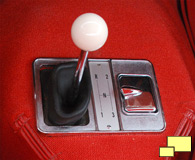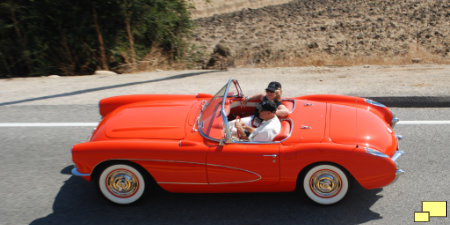Corvette Generations:
C1 C2 C3 C4 C5 C6 C7 C8
Corvette: Year by Year
1953 1954 1955 1956 1957 1958 1959 1960 1961 1962 19631964 1965 1966 1967 1968 1969 1970 1971 1972 1973 1974
1975 1976 1977 1978 1979 1980 1981 1982 1983 1984 1985
1986 1987 1988 1989 1990 1991 1992 1993 1994 1995 1996
1997 1998 1999 2000 2001 2002 2003 2004 2005 2006 2007
2008 2009 2010 2011 2012 2013 2014 2015 2016 2017 2018
2019 2020 2021 2022 2023 2024 2025
1956 Chevrolet Corvette:
New Styling and a Future Classic
More importantly, its destiny as Americas premier competitive sports car would take shape.
Many of the problems that plagued the 1953-55 models were addressed. The new design featured outside door handles, roll-up windows and a factory sourced hardtop was available. Power windows and a power top were options. The interior remained the same.
 Right: Three speed manual transmission, first seen in a Corvette in 1955, was the standard transmission in 1956. It continued as the standard transmission until 1969. The two speed Powerglide Automatic Transmission (Code 313, $188.50) would be available until 1967.
Right: Three speed manual transmission, first seen in a Corvette in 1955, was the standard transmission in 1956. It continued as the standard transmission until 1969. The two speed Powerglide Automatic Transmission (Code 313, $188.50) would be available until 1967.
Introducing the Coves
 Right: 1956 Corvette exhaust outlet. Corvette engineer Zora Arkus-Duntov did an exhaust gas flow study on the 1954 Corvette and the '56 outlet design was the result.
Right: 1956 Corvette exhaust outlet. Corvette engineer Zora Arkus-Duntov did an exhaust gas flow study on the 1954 Corvette and the '56 outlet design was the result.
Chevrolet went racing with the latest Corvette and was rewarded with excellent success. It started in January 1956 when John Fitch set a production car record of 145 MPH at Daytona Speed Week. He then drove a stock 1956 Corvette at the NASCAR speed week Flying Mile event in Daytona, setting a speed record of 145.543 mph.
New suspension revisions by Zora Arkos-Duntov gave Chevrolet the confidence to enter four Corvettes in the Florida International 12-Hour Grand Prix of Endurance, at Sebring, Florida. One car, entered in the C/Modified class finished first in its class and ninth overall. A car entered in B/Production finishes sixth in class / 15th overall. Another retired after only 20 minutes with a broken axle shaft. The fourth car, also entered in B/Production, blew its engine one hour and 20 minutes into the race.
1956 Corvette Options, Prices
| RPO | Description | Production | Price |
| 101 | Heater | n/a | $123.65 |
| 102 | AM Radio, Signal Seeking | 2,717 (78.37%) | $198.90 |
| 107 | Parking Brake Alarm | 2,685 (77.44%) | $5.40 |
| 108 | Courtesy Lights | 2,775 (80.04%) | $8.65 |
| 109 | Windshield Washers | 2,815 (81.19%) | $11.85 |
| 290 | Whitewall Tires, 6.70x15 | n/a | $32.30 |
| 313 | Powerglide Automatic Transmission | n/a | $188.50 |
| 419 | Auxiliary Hardtop | 2,076 (59.88%) | $215.20 |
| 426 | Power Windows | 547 (15.78%) | $64.60 |
| 440 | Two-Tone Paint Combination | 1,259 (36.31%) | $19.40 |
| 449 | Special High-Lift Camshaft | 111 (3.20%) | $188.30 |
| 469 | 265ci, 225hp Engine (2 4 bbl. carburetors) | 3,080 (88.84%) | $172.20 |
| 471 | Rear Axle, 3.27:1 ratio | n/a | n/a |
| 473 | Power Operated Folding Top | 2,682 (77.36%) | $107.60 |
|
Total Production:
3,467
Notes: Base Corvette with 265 cu. in. engine and three speed manual transmission: $3,120.00 |
|||
Colors
| Code | Exterior | Quantity | Interior | Soft Top | Wheels |
| Onyx Black | 810 (23.36%) | Red | Black / White | Black | |
| Aztec Copper | 402 (11.60%) | Beige | Beige / White | Copper | |
| Cascade Green | 290 (8.36%) | Beige | Beige / White | Green | |
| Arctic Blue | 390 (11.25%) | Beige / Red | Beige / White | Blue | |
| Venetian Red | 1,040 (30.00%) | Red | Beige / White | Red | |
| Polo White | 532 (15.34%) | Red | Black / White | Red | |
|
Notes: Interior quantities: Beige: 887; Red: 2,580. |
|||||
















